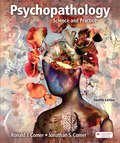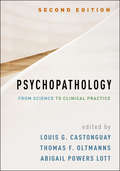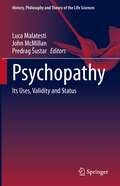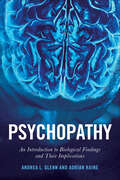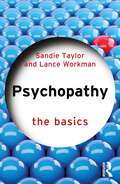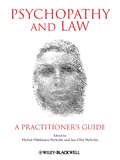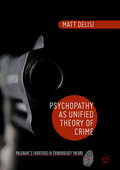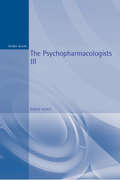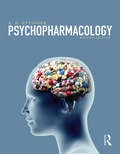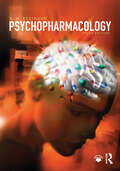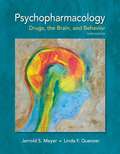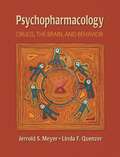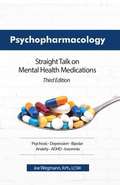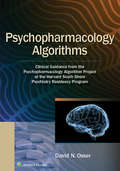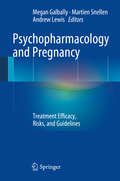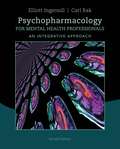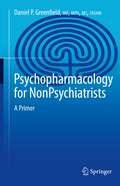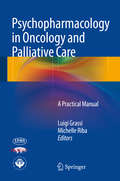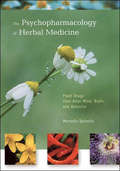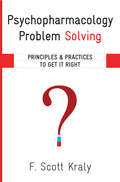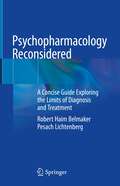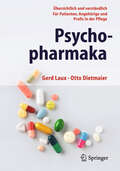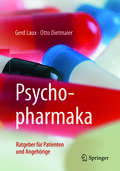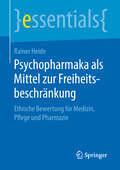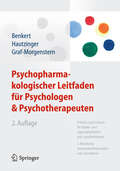- Table View
- List View
Psychopathology: Science and Practice
by Ronald J. Comer Jonathan S. ComerPsychopathology: Science and Practice (formerly Abnormal Psychology) is the market-leading introduction to mental disorders and their treatment using vivid case studies, compelling examples, and the latest research.
Psychopathology, Second Edition: From Science to Clinical Practice
by Thomas F. Oltmanns Louis G. Castonguay Abigail Powers LottThe text of choice for instructors looking for an innovative, empirically based, and practice-oriented perspective on psychopathology is now in a revised and expanded second edition with 50% new material. The volume presents state-of-the-art information on the disorders most frequently seen in clinical practice, reviewing their etiology, DSM-5 classification, symptoms and clinical features, course, epidemiology, and associated comorbidities. With the goal of integrating science and practice, each chapter also provides substantive therapeutic guidelines derived from the research. Contributors identify underlying principles of change that clinicians can draw on to improve their effectiveness and offer critical guidance for assessment, case formulation, and evidence-based intervention. New to This Edition *Chapters on new topics--suicide, sleep difficulties, and sexual dysfunction. *New chapter on an existing topic: schizophrenia. *Updated throughout with current theory, findings, and clinical advances. *Increased attention to transdiagnostic concerns.
Psychopathy: Its Uses, Validity and Status (History, Philosophy and Theory of the Life Sciences #27)
by John McMillan Luca Malatesti Predrag ŠustarThis book explains the ethical and conceptual tensions in the use of psychopathy in different countries, including America, Canada, the UK, Croatia, Australia, and New Zealand. It offers an extensive critical analysis of how psychopathy functions within institutional and social contexts. Inside, readers will find innovative interdisciplinary analysis, written by leading international experts. The chapters explore how different countries have used this diagnosis. A central concern is whether psychopathy is a mental disorder, and this has a bearing upon whether it should be used. The book’s case studies will help readers understand the problems associated with psychopathy. Academics and students working in the philosophy of psychiatry, bioethics, and moral psychology will find it a valuable resource. In addition, it will also appeal to mental health professionals working in forensic settings, psychologists with an interest in the ethical implications of the use of psychopathy as a construct and particularly those with a research interest in it.
Psychopathy: An Introduction to Biological Findings and Their Implications (Psychology and Crime #1)
by Adrian Raine Andrea L GlennA concise overview of the neuropsychology of psychopathy, written in layman's termsThe last two decades have seen tremendous growth in biological research on psychopathy, a mental disorder distinguished by traits including a lack of empathy or emotional response, egocentricity, impulsivity, and stimulation seeking. But how does a psychopath’s brain work? What makes a psychopath?Psychopathy provides a concise, non-technical overview of the research in the areas of genetics, hormones, brain imaging, neuropsychology, environmental influences, and more, focusing on explaining what we currently know about the biological foundations for this disorder and offering insights into prediction, intervention, and prevention. It also offers a nuanced discussion of the ethical and legal implications associated with biological research on psychopathy. How much of this disorder is biologically based? Should offenders with psychopathic traits be punished for their crimes if we can show that biological factors contribute? The text clearly assesses the conclusions that can and cannot be drawn from existing biological research, and highlights the pressing considerations this research demands.
Psychopathy: The Basics (The Basics)
by Sandie Taylor Lance WorkmanPsychopathy: The Basics is an accessible text that provides a compact introduction to the major findings and debates concerning this complex personality disorder. This book provides an overview of the field and covers a wide range of research findings from genetics to psychosocial developmental explanations. It begins with an exploration of the historical conception of the phenomenon of psychopathy and goes on to discuss its social and cultural accounts. It also delves into biologically based explanations including genetic and evolutionary approaches, along with criminological and entrepreneurial types of psychopathy. Offering a balanced perspective, thisbook addresses the nature-nurture debate in the field and also discusses widely accepted personality traits of psychopaths. Lastly, it also provides a glossary of key terms and suggestions for further reading This book will be an essential read for students of forensic psychology, or criminology. It is also an ideal starting point for those interested in the science of psychopathy and personality disorders.
Psychopathy and Law
by Helinä Häkkänen-Nyholm Jan-Olof Nyholm L. L. M.Psychopathy and Law: A Practitioner's Guide provides those working in the fields of law, the military, social and health services, politics, and business with a comprehensive introduction to psychopathy and the ways of thinking that guide the psychopathic mind. Features case examples and - unique from previous texts in the field - links these to theory and empirical research Represents an up-to-date resource for scientists examining psychopathy Covers issues that have never been dealt with in regard to psychopathy, including those relating to families, civil law, war crimes, economical crimes and organized crimes
Psychopathy as Unified Theory of Crime
by Matt DelisiThis book applies the psychopathy concept toward the understanding of crime. Drawing on hundreds of studies and his own clinical, research, and practitioner experience working with the most antisocial and violent offenders, the author demonstrates that psychopathy can explain all forms of crime across the life course, and also examines the biosocial foundations of the disorder. With an abundance of case studies and historical references, written in a distinctive writing style, the book is equally fascinating to the academic scholar and the true crime buff alike.
The Psychopharmacologists 3
by David HealyThe Psychopharmacologists 3 completes a trio of interview-based books about the process of therapeutic innovation in clinical psychiatry. David Healy's method is to interview key individuals involved in the discovery and deployment of drugs that have proved useful to psychiatry, and to draw them together within a model of the mechanism and clinical discovery that he uses as an overall framework.These are historical accounts but highly relevant to the clinical psychiatrist of today, emphasising the importance of research, and of the marketing strategies of pharmaceutical companies in formulating disease entities as well as treatments for them.
Psychopharmacology
by R. H. EttingerWith increases in the prevalence of psychiatric and behavioral disorders and rapid advances in the development of new drug therapies, there is an increasing need to present the science behind these developments. Students and educators are often confronted with conflicting and exaggerated claims about the effectiveness of drugs. As recently as ten years ago, the mechanisms of action of many medications prescribed for common psychological disorders were not well understood, even by the scientists developing them. Now, drug treatment has advanced to a stage where drugs are designed for their effects on specific receptors, membrane proteins, or secondary messengers within particular cells in the brain. This text introduces a sufficient background in neuroanatomy and physiology so students can comprehend the necessary details of drug action. Psychopharmacology, Second Edition, presents its subject matter in the context of the behavioral disorders they are designed to treat, rather than by traditional drug classifications. Students are often familiar with the major diagnostic categories, so presenting psychopharmacology as it pertains to these familiar disorders strengthens their understanding of the physiology and neurochemistry underlying them as well as the approaches to their treatment. Each disorder is discussed from a historical context along with diagnostic criteria and descriptions of typical cases. In addition, what we presently know about the underlying pathology of each disorder is carefully described. A critical examination of drug claims is missing from most psychopharmacology texts, but is offered here. Students will read about the most current research available from a critical perspective. When alternatives to traditional drug therapies are supported by research, these studies are presented as well. Throughout, this text discusses how drug effectiveness is measured in both human and animal studies. Psychopharmacology has contributed significantly over the past 75 years to the treatment of severe psychological disorders as well as to our understanding of the brain and human behavior. This symbiotic relationship between psychopharmacology and the neural and behavioral sciences will continue long into the future. This fully updated second edition is ideal for undergraduate and pre-professional students, and includes a robust companion website.
Psychopharmacology
by R. H. EttingerThis new, and heavily revised, edition of Psychopharmacology, provides a comprehensive scientific study of the effects of drugs on the mind and behavior. With the growing prevalence of psychiatric and behavioral disorders and the rapid advances in the development of new drug therapies, this textbook offers an essential understanding of the necessary details of drug action. The book presents its coverage in the context of the behavioral disorders they are designed to treat, rather than by traditional drug classifications, to strengthen understanding of the underlying physiology and neurochemistry, as well as the approaches to treatment. Each disorder from the major diagnostic categories is discussed from a historical context along with diagnostic criteria and descriptions of typical cases. In addition, what we presently know about the underlying pathology of each disorder is carefully described. Providing a solid foundation in psychology, neuroanatomy and physiology, the book also offers a critical examination of drug claims, as well as coverage of evidence-based alternatives to traditional drug therapies. Throughout, this text discusses how drug effectiveness is measured in both human and animal studies. Topics new to this edition include: a stronger emphasis on the environmental impacts on drug effectiveness; more on the mechanisms of adverse reactions to drugs and information on managing drug side effects; the risks and benefits of using "mood stabilizing drugs" to address behavior in youth with ADHD or ASD; and discussion of the research-to-practice gap in pharmacological care for children and adolescents. Accompanied by a robust selection of support material, this textbook is ideal for undergraduate and pre-professional students on courses in Psychopharmacology, Clinical Psychopharmacology, Drugs and Behavior. It is a valuable contribution to highlight the symbiotic relationship between psychopharmacology and the neural and behavioral sciences.
Psychopharmacology: Drugs, The Brain, And Behavior
by Jerrold Meyer Linda QuenzerUnique in its breadth of coverage ranging from historical accounts of drug use to clinical and preclinical behavioral studies, Psychopharmacology is appropriate for undergraduates studying the relationships between the behavioral effects of psychoactive drugs and their mechanisms of action.
Psychopharmacology: Drugs, the Brain, and Behavior
by Jerrold S. Meyer Linda F. QuenzerRecent advances in molecular pharmacology and brain imaging have revolutionized our understanding of how psychoactive drugs work. Now, from the authors of Principles of Neuropsychopharmacology, comes a new undergraduate textbook integrating these developments. The first section of the book provides extensive foundation materials, including the basic principles of pharmacology, neurophysiology and neuroanatomy, synaptic transmission, and methods in psychopharmacology. The second section describes key features of major neurotransmitter systems, including the catecholamines, serotonin, acetylcholine, glutamate and GABA. The third and fourth sections discuss theories and mechanisms of drug addiction and psychopathology. All major substances of abuse as well as drugs used to treat mental illness are covered.
Psychopharmacology: Straight Talk on Mental Health Medications
by Joseph Wegmann<p>Congratulations to Joe Wegmann, and his book, Psychopharmacology, 3rd Edition, for winning a silver medal at the 2016 IBPA Benjamin Franklin Awards for editorial and design excellence in the Professional & Technical category. <p>This is the definitive guide and desk reference for healthcare professionals and patients to expand their knowledge in the pharmacological and behavioral treatment of psychosis, anxiety, depression, bipolar, insomnia and ADHD.</p>
Psychopharmacology Algorithms: Clinical Guidance from the Psychopharmacology Algorithm Project at the Harvard South Shore Psychiatry Residency Program
by David OsserAlgorithms serve an important purpose in the field of psychopharmacology as heuristics for avoiding the biases and cognitive lapses that are common when prescribing for many conditions whose treatment is based on complex data. Unique in the field, this title compiles twelve papers from the Psychopharmacology Algorithm Project at the Harvard South Shore Psychiatry Residency Training Program and presents practical ways to adopt evidence-based practices into the day-to-day treatment of patients. Psychopharmacology Algorithms is a useful resource for practicing psychiatrists, residents, and fellows, as well as psychiatric nurse practitioners, psychiatric physician assistants who prescribe, advanced practice pharmacists who prescribe, and primary care clinicians. Teachers of psychopharmacology may find it particularly valuable. Researchers in clinical psychopharmacology may find it helpful in identifying important practice areas that are in need of further study.
Psychopharmacology and Pregnancy
by Megan Galbally Martien Snellen Andrew LewisThis book examines the role of psychopharmacological treatment in a range of disorders that may be encountered during pregnancy, including major depressive disorders, anxiety disorders, bipolar affective disorder, schizophrenia, eating disorders and substance abuse. The natural history of each condition pre and post-partum is analyzed and the evidence for the efficacy of drug treatments, evaluated. Special attention is paid to the potential dangers of different treatment options for both mother and fetus, covering risks of malformation, pregnancy and obstetric risks, neonatal risks and possible long-term consequences. The risks of not treating a particular condition are also analyzed. On the basis of the available evidence, management guidelines are provided that additionally take into account non-pharmacological options. Closing chapters consider the value of complementary and alternative medicine and ECT and explore future research directions.
Psychopharmacology for Mental Health Professionals: An Integrative Approach (2nd Edition)
by R. Elliott Ingersoll Carl F. RakThis book is an introductory level text on psycho-pharmacology for students preparing for careers in psychology, counselling, and social work.
Psychopharmacology for Nonpsychiatrists: A Primer
by Daniel P. GreenfieldThis unique, easy-to-read title offers a concise, practical guide to psychopharmacology and psychopharmacotherapy. Designed for a wide range of practitioners and trainees in general and mental healthcare, this invaluable primer provides foundational information for those who wish to cultivate a deeper understanding of the often-mysterious psychopharmacology medication family. Unlike other books on this topic, the primer positions psychopharmacology within the larger context of psychiatric and psychological treatment and also discusses the variety of therapeutic and somatic techniques available to providers and their patients. Further, since many patients with psychiatric conditions unfortunately find themselves interacting with the justice system, the author offers useful considerations related to the intersection of mental health and the law.The primer consists of 13 chapters and is organized in four parts: Part 1 covers essentials of pharmacology and psychopharmacology, outlining the basic principles of pharmacology, psychopharmacology, and psychopharmacotherapy. Part 2 addresses therapies that may involve psychopharmacology/ psychopharmacotherapy, providing a succinct overview of selected and representative types of psychotherapy and counseling in contemporary psychiatry and psychology. Part 3 discusses forensic and legal applications of psychopharmacology/ psychopharmacotherapy, drawing on the author’s long experience in various aspects of forensic psychiatry. Part 4 consists of one final chapter, titled “Synthesis and Conclusions.” This chapter pulls together the most salient points of the book to assist the reader in the practical psychopharmacotherapeutic treatment of patients/clients.A timely and invaluable contribution to the literature, Psychopharmacology for Non-Psychiatrists: A Primer will be of great benefit as a user-friendly resource for professionals or as an exam-preparation book for medical students and trainees in a wide range of mental health fields. Specifically, the primer will be of great interest to primary care physicians, nurse practitioners, physician assistants, counselors, therapists, non-psychiatric physicians and dentists whose practices involve psychopharmacotherapy, naturopaths, homeopaths, physical therapists, occupational therapists, and speech/language therapists. Legal professionals and others who are not themselves healthcare professionals, but who interact with healthcare professionals, also will find the primer a handy resource.
Psychopharmacology in Oncology and Palliative Care
by Luigi Grassi Michelle RibaThis practical manual presents the main drugs and protocols currently used in the psychopharmacological treatment of psychiatric disorders in cancer and palliative care settings and explores the principal issues involved in such treatment. Significant clinical challenges encountered in the psychopharmacological management of various psychiatric conditions are discussed, covering aspects such as side-effects and drug-drug interactions. Attention is also paid to the emerging theme of adjuvant use of psychotropic drugs for the treatment of symptoms or syndromes not primarily related to psychiatric disorders. In addition, practical suggestions are provided for dealing with special populations, including children and the elderly. The book is designed to be easy to read and to reference, with helpful concise tables and boxes. The authors include some of the most renowned clinicians working in the field of psycho-oncology.
The Psychopharmacology of Herbal Medicine: Plant Drugs That Alter Mind, Brain, and Behavior
by Marcello SpinellaA compilation of current scientific knowledge about psychoactive herbal drugs.Virtually all cultures consume drugs from psychoactive plants. Caffeine, for example, is probably the most common stimulant in the world, and many modern medicines, such as morphine and codeine, are derived from plant sources. In these cases, scientific research has revealed the composition of the plants and how they interact with the nervous system. There are also many herbal medications with reputed therapeutic value that have not yet gained acceptance into mainstream medicine, partly because there has not been enough research to support their usefulness. Instead they are regarded as "alternative medicines." This is an active research area, however, and many current studies are focusing on identifying the active components, pharmacological properties, physiological effects, and clinical efficacy of herbal medicines. This book compiles and integrates the most up-to-date information on the major psychoactive herbal medicines—that is, herbal medicines that alter mind, brain, and behavior. It focuses particularly on the effects on various areas of cognition, including attention, learning, and memory. The book covers all major classes of psychoactive drugs, including stimulants, cognitive enhancers, sedatives and anxiolytics, psychotherapeutic herbs, analgesics and anesthetic plants, hallucinogens, and cannabis.
Psychopharmacology Problem Solving: Principles and Practices to Get It Right
by F. Scott KralyAt last, a clinician's guidebook to prescription dilemmas. Psychotropic medications prescribed to treat mental disorders have become increasingly commonplace over the past half century, but the decision-making process for doing so continues to lack real clarity. Clinicians and patients alike face new challenges and questions thanks to the increasing availability of these drugs: When is the right time to prescribe something? Can I predict which drug will help this individual? When do I consider changing a medication? How do I assess whether a drug's side effects make it worthwhile or not? The response to these challenging questions is not to stop medicating altogether. Psychotropic medications are useful clinical tools. But now more than ever we must consider what it means to medicate judiciously. It is time to slow down, pause, maybe even back up a bit, and reconsider how and why various drugs should be prescribed and monitored for success. The goal of this book is to encourage prudent, informed, and appropriate use of psychotropic medications--to encourage use that is respectful and aware of the strengths and limitations of these drugs. By presenting some fundamental principles of pharmacology as they apply to the clinical treatment of patients, and by offering practical, big-picture prescribing recommendations, Psychopharmacology Problem Solving helps to unravel an increasingly complex decision-making process. The first part of the book offers guidelines to keep in mind when working toward making informed choices regarding drug therapy. The second part of the book offers select examples of behavioral problems and psychological disorders--including addiction, obesity, schizophrenia, depression, anxiety, and ADHD--to illustrate how the principles or recommendations presented in Part I actually play out. The book concludes by considering the persistent problems and challenges that we face in our current and future use of psychotropic medications. Taking a hard look at the extraordinary and increasing trust clinicians, patients, and families of patients place in drug therapy for mental illness, this book gives readers an evidence-based anchor to help them make the right decisions.
Psychopharmacology Reconsidered: A Concise Guide Exploring the Limits of Diagnosis and Treatment
by Robert Belmaker Pesach LichtenbergThis thought-provoking book covers the full range of psychopharmacologic practice in textbook fashion, offering a fresh and comprehensive self-examination. Unlike conventional texts of psychopharmacology, this text speaks directly to clinicians who have started to question the limitations of psychopharmacologic claims and the rigid confines of DSM-5 diagnoses. Drawing from their clinical and research experience as well as new literature, the well-published authors provide a new perspective that encourages readers to reevaluate established practices and embrace that medication is just one component of treatment and has limits. The book could be used by psychiatric residents in their course of study, by clinical psychology students taking a psychopharmacology course, or by psychiatrists curious to get a readable but comprehensive look at new critical viewpoints in psychopharmacology that have changed since they were taught. Many neuroscience students who are looking for a review of clinical effects to guide their basic research may also find the proposed text more useful than those texts that collate clinical trials.Current texts are for specialized scientists or are part of multi-authored texts which list drugs alphabetically with no conceptual framework, or books that pretend that each biochemical drug property has a clear and known clinical result presented in cartoon style. Some lesser known texts for psychology or nursing students are not authoritative. Others aimed at patients or families are too simplistic for clinicians. The authors’ goal was to create a unified text expressing their view of psychopharmacology, its evidence base, the unity of its essential principles, and its independence of DSM or ICD diagnosis.Several new history books describe the "rise and fall" of psychopharmacology, the corruption of big pharma and the failure of large controlled clinical trials. Psychopharmacology Reconsidered: A Concise Guide Exploring the Limits of Diagnosis and Treatment ensures that young clinicians are aware of and understand this critical zeitgeist but aware also of the essential core of psychopharmacology and the evidence upon which it rests.
Psychopharmaka
by Otto Dietmaier Gerd LauxIn diesem Ratgeber erfahren Patienten und Angehörige, was sie über Psychopharmaka und ihren Nutzen wissen müssen: Wie wirken die Substanzen? Welche Nebenwirkungen haben Psychopharmaka? Wo liegen die Grenzen dessen, was Psychopharmaka leisten können? Verständlich präsentieren die Autoren Fakten, sie räumen mit Mythen auf und treten damit Vorbehalten und Vorurteilen entgegen, die häufig über Psychopharmaka geäußert werden.
Psychopharmaka: Ratgeber für Patienten und Angehörige
by Otto Dietmaier Gerd LauxIn diesem Ratgeber erfahren Patienten und Angehörige, was sie über Psychopharmaka und ihren Nutzen wissen müssen: Wie wirken die Substanzen? Welche Nebenwirkungen haben Psychopharmaka? Wo liegen die Grenzen dessen, was Psychopharmaka leisten können? Verständlich präsentieren die Autoren Fakten, sie räumen mit Mythen auf und treten damit Vorbehalten und Vorurteilen entgegen, die häufig über Psychopharmaka geäußert werden.
Psychopharmaka als Mittel zur Freiheitsbeschränkung: Ethische Bewertung für Medizin, Pflege und Pharmazie (essentials)
by Rainer HeidePsychopharmaka werden in jüngster Zeit vermehrt als Mittel einer möglichen Freiheitsbeschränkung besonders in Einrichtungen der stationären Altenpflege angesehen. Der Autor beleuchtet das Thema sowohl pharmazeutisch und medizinisch als auch rechtsphilosophisch, insbesondere aber aus dem moral-philosophischen und ethischen Blickwinkel.
Psychopharmakologischer Leitfaden für Psychologen und Psychotherapeuten
by Philip Heiser Martin Hautzinger Otto Benkert Christoph Hiemke Eberhard Schulz Mechthild Graf-MorgensternEine optimale Therapie ist heute bei den meisten psychischen Störungen ohne Psychopharmaka nicht mehr vorstellbar, genauso wenig wie eine Behandlung in der Psychiatrie ohne Psychotherapie. In dem Buch werden die Spezifika der Psychopharmakotherapie in allen ihren Facetten besprochen und der Einsatz der Medikamente in einem Gesamtbehandlungsplan bewertet. Jedes Kapitel endet mit Kontrollfragen, so dass sich psychologische Psychotherapeuten auf die Abschlussprüfung vorbereiten oder ihren Kenntnisstand überprüfen können.
